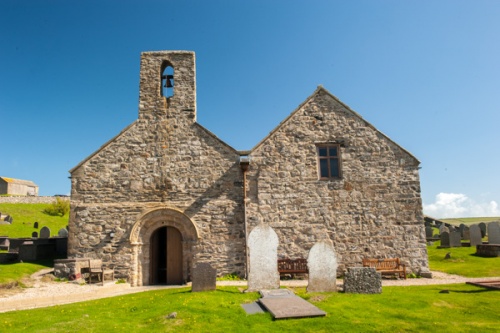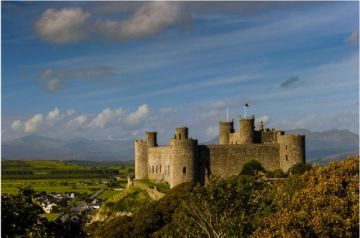
A church was built in Aberdaron in the 5th century, in a clifftop location overlooking the sea. The founder was Hywyn, who established a prayer cell where he lived and preached to the nearby inhabitants. The current church was begun around 1137 as part of a concerted effort by Gruffudd ap Cynan, King of Gwynedd, to replace earlier wooden structures with stone.
The new church became a place of sanctuary, where fugitives could earn 40 days of respite from pursuit, and disputes could be heard. The Norman building was enlarged in the 15th century, and in the early 17th century Aberdaron was granted to St John's College, Cambridge, in whose possession it remained for over 300 years.
For centuries the church has been a stopping place for pilgrims on their way to Bardsey, off the south west tip of the Lleyn peninsula.
The most interesting architectural feature of St Hywyn's is the wonderful Norman west door, but even more intriguing are a pair of carved stones displayed against the north east wall. The stones are thought to be the gravestones of two early priests, Veracius and Senacus. They were discovered at Mynydd Anelog, near the current Gors farm. It is possible that the priests were members of a small religious community there.
The left hand stone is inscribed, 'VERACIUS PBR HIC IACIT' which translates as, 'Veracius priest lies here'. The right hand stone is inscribed 'SENACUS PRSB HIC IACIT CUM MULTITU DNEM FRATRUM PRESBYTER', which translates as 'SENACUS PRIEST LIES HERE WITH MANY BRETHREN PRIEST '. The stones were probably carved in the late 5th or early 6th century.
About Aberdaron, St Hywyn's Church
Address: Aberdaron,
Pwllheli,
Lleyn Peninsula,
Gwynedd,
Wales, LL53 8BE
Attraction Type: Historic Church
Location: On the B4413. There is a very small parking area outside the church.
Website: Aberdaron, St Hywyn's Church
Location
map
OS: SH172 262
Photo Credit: David Ross and Britain Express
POPULAR POSTS
HERITAGE
 We've 'tagged' this attraction information to help you find related historic attractions and learn more about major time periods mentioned.
We've 'tagged' this attraction information to help you find related historic attractions and learn more about major time periods mentioned.
Find other attractions tagged with:
15th century (Time Period) - 17th century (Time Period) - 19th century (Time Period) - 5th century (Time Period) - 6th century (Time Period) - Norman (Architecture) -
NEARBY HISTORIC ATTRACTIONS
Heritage Rated from 1- 5 (low to exceptional) on historic interest
Porth Oer (Whistling Sands) - 2.2 miles (Countryside) ![]()
Llanfaelrhys, St Maelrhys Church - 2.4 miles (Historic Church) ![]()
Plas-yn-Rhiw - 4.1 miles (Historic House) ![]()
Llanengan, St Engan's Church - 7.5 miles (Historic Church) ![]()
Castell Carn Fadrun - 8.5 miles (Castle) ![]()
Tre'r Ceiri Hillfort - 16.4 miles (Prehistoric Site) ![]()
Penarth Fawr - 16.7 miles (Historic House) ![]()
St Cybi's Well - 18.2 miles (Historic Church) ![]()
Nearest Holiday Cottages to Aberdaron, St Hywyn's Church:
More self catering near Aberdaron, St Hywyn's Church











